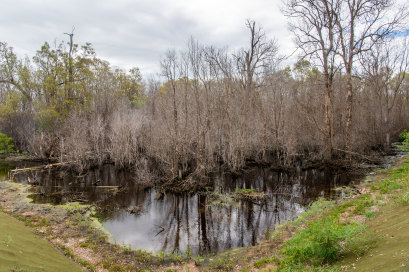
In a concise statement of response tendered to the court, lawyers for the Commonwealth acknowledged: “The Torres Strait Islands are vulnerable to some impacts of climate change, such as rising sea levels, and that some of the impacts of climate change have already been felt in that region.”
However, they say, asking the court to impose a “duty of care” responsibility on the federal government of the kind sought would require the court to assess questions of policymaking.

Trees killed by seawater inundation on an island in the Torres Strait.Credit: Justin McManus
Grata Foundation founder and executive director Isabelle Reinecke, whose organisation is supporting the First Peoples’ case, said the Torres Strait Treaty, signed by Australia and Papua New Guinea in 1978 and which provides a framework for managing the common border area between the two countries, would be key to the legal challenge.
“Australia agreed with Papua New Guinea and the Torres Strait that Australia would provide protection to the people, the culture, and the environment of the Torres Strait,” Reinecke said. “And when [Australia] signed that treaty they took on a legal obligation to the Torres Strait.”
According to figures collated by the Bureau of Meteorology, the mean sea levels recorded at Thursday Island, also in the Torres Strait, rose from 1.78 metres in 2015 to 2.02 metres this year.
Kabai said he had seen devastating changes in his lifetime on Saibai Island. As the sea levels rose, saltwater inundated inland swamps where barramundi and crabs once lived.
His family once grew taro, cassava, yam, sweet potatoes, pumpkins, sugar cane and bananas in gardens near their home. Those gardens have been abandoned for two decades.
“When I was a child, we only bought sugar, salt, flour and rice at the shop, but we would otherwise eat the food from our gardens, and we would also be able to get dugong, turtle, barramundi and crabs to eat as well,” he said. Now, his family has to buy most of their food from shops.
Phi Finney McDonald principal lawyer Brett Spiegel argues that Australia has acknowledged its commitment to real climate action by signing up to the Paris Agreement’s targets of limiting temperature increases to no more than 1.5 degrees.
Loading
“Given they’ve made that commitment, it is inconsistent to then fail to actually engage with the climate science to ensure that you’re setting targets that are in accordance with those previous policy decisions,” Spiegel told this masthead.
Lawyers for the government maintain global action is needed for meaningful mitigation of climate change, and argue Australia contributes only “a very small proportion” of global greenhouse gas emissions.
“Climate change is a global problem and global action is required in order to have a meaningful impact on climate change,” the government’s response, tendered to the court, states. “It is not possible for [Australia], by itself, to prevent or materially mitigate climate change or its impacts.”
It is an argument the traditional owners hope the court will reject.
“On a per capita basis, Australia is one of the highest emitters in the world,” Spiegel said.
“And even when one factors in that Australia’s population is quite small, it still is one of the top 20 emitters in the world. So by that argument, virtually no country’s emissions would make any difference.”
Back on Saibai, the thought of losing the battle against climate change mitigation is unimaginable.
“It is very hard for me to talk about what it would mean if Saibai was lost, or if I had to leave it because it was underwater or uninhabitable,” Kabai wrote in a submission to the court.
“My country would disappear. I would lose everything: my home, my community, my culture, my stories and my identity. Without Saibai, I do not know who I would be.”









 Add Category
Add Category